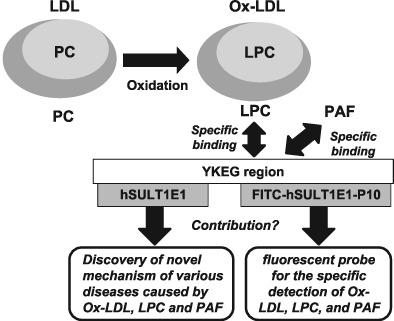当前位置:
X-MOL 学术
›
J. Pept. Sci.
›
论文详情
Our official English website, www.x-mol.net, welcomes your feedback! (Note: you will need to create a separate account there.)
Human estrogen sulfotransferase and its related fluorescently labeled decapeptides specifically interact with oxidized low-density lipoprotein.
Journal of Peptide Science ( IF 2.1 ) Pub Date : 2020-07-06 , DOI: 10.1002/psc.3274 Akira Sato 1, 2 , Miyuki Yamazaki 1 , Hinako Watanabe 1 , Eiko Sakurai 1, 2 , Keiichi Ebina 1, 2
Journal of Peptide Science ( IF 2.1 ) Pub Date : 2020-07-06 , DOI: 10.1002/psc.3274 Akira Sato 1, 2 , Miyuki Yamazaki 1 , Hinako Watanabe 1 , Eiko Sakurai 1, 2 , Keiichi Ebina 1, 2
Affiliation

|
Estrogen sulfotransferase (SULT1E) mainly catalyzes the sulfation of estrogens, which are known to prevent the pathogenesis of atherosclerosis. Recently, we found that peptides with a YKDG sequence specifically bind to oxidized low‐density lipoprotein (Ox‐LDL), which plays a major role in the pathogenesis of atherosclerosis. Here, we investigated the interaction between human SULT1E1 (hSULT1E1), which has a YKEG sequence (residues 61–64) unlike other human SULTs, and Ox‐LDL. Results from polyacrylamide gel electrophoresis and western blotting demonstrated that hSULT1E1 specifically binds to Ox‐LDL and its major lipid component (lysophosphatidylcholine; LPC), and platelet‐activating factor (PAF), which bears a marked resemblance to LPC in terms of structure and activity. Moreover, an N‐terminally fluorescein isothiocyanate (FITC)‐labeled decapeptide (MIYKEGDVEK; FITC‐hSULT1E1‐P10) corresponding to residues 59–68 of hSULT1E1 specifically binds to Ox‐LDL, LPC, and PAF. Unveiling the specific interaction between hSULT1E1 and Ox‐LDL, LPC, and PAF provides important information regarding the mechanisms underlying various diseases caused by Ox‐LDL, LPC, and PAF, such as atherosclerosis. In addition, FITC‐hSULT1E1‐P10 could be used as an efficient fluorescent probe for the detection of Ox‐LDL, LPC, and PAF, which could facilitate the mechanistic study, identification, diagnosis, prevention, and treatment of atherosclerosis.
中文翻译:

人雌激素磺基转移酶及其相关的荧光标记的十肽与氧化的低密度脂蛋白特异性相互作用。
雌激素磺基转移酶(SULT1E)主要催化雌激素的硫酸化,已知这可以预防动脉粥样硬化的发病机理。最近,我们发现具有YKDG序列的肽与氧化型低密度脂蛋白(Ox-LDL)特异性结合,这在动脉粥样硬化的发病机理中起着重要作用。在这里,我们研究了与其他人类SULT不同的具有YKEG序列(残基61-64)的人类SULT1E1(hSULT1E1)与Ox-LDL之间的相互作用。聚丙烯酰胺凝胶电泳和蛋白质印迹的结果表明,hSULT1E1特异性结合Ox-LDL及其主要脂质成分(溶血磷脂酰胆碱; LPC)和血小板活化因子(PAF),在结构和活性方面与LPC具有明显相似之处。此外,N端异硫氰酸荧光素(FITC)标记的十肽(MIYKEGDVEK; FITC-hSULT1E1-P10)对应于hSULT1E1的59-68位残基,与Ox-LDL,LPC和PAF特异性结合。揭示hSULT1E1与Ox-LDL,LPC和PAF之间的特定相互作用可提供有关Ox-LDL,LPC和PAF引起的各种疾病(如动脉粥样硬化)的潜在机制的重要信息。此外,FITC-hSULT1E1-P10可用作检测Ox-LDL,LPC和PAF的有效荧光探针,可促进动脉粥样硬化的机理研究,鉴定,诊断,预防和治疗。PAF提供了有关Ox-LDL,LPC和PAF引起的各种疾病(如动脉粥样硬化)的潜在机制的重要信息。此外,FITC-hSULT1E1-P10可用作检测Ox-LDL,LPC和PAF的有效荧光探针,可促进动脉粥样硬化的机理研究,鉴定,诊断,预防和治疗。PAF提供了有关Ox-LDL,LPC和PAF引起的各种疾病(如动脉粥样硬化)的潜在机制的重要信息。此外,FITC-hSULT1E1-P10可用作检测Ox-LDL,LPC和PAF的有效荧光探针,可促进动脉粥样硬化的机理研究,鉴定,诊断,预防和治疗。
更新日期:2020-07-06
中文翻译:

人雌激素磺基转移酶及其相关的荧光标记的十肽与氧化的低密度脂蛋白特异性相互作用。
雌激素磺基转移酶(SULT1E)主要催化雌激素的硫酸化,已知这可以预防动脉粥样硬化的发病机理。最近,我们发现具有YKDG序列的肽与氧化型低密度脂蛋白(Ox-LDL)特异性结合,这在动脉粥样硬化的发病机理中起着重要作用。在这里,我们研究了与其他人类SULT不同的具有YKEG序列(残基61-64)的人类SULT1E1(hSULT1E1)与Ox-LDL之间的相互作用。聚丙烯酰胺凝胶电泳和蛋白质印迹的结果表明,hSULT1E1特异性结合Ox-LDL及其主要脂质成分(溶血磷脂酰胆碱; LPC)和血小板活化因子(PAF),在结构和活性方面与LPC具有明显相似之处。此外,N端异硫氰酸荧光素(FITC)标记的十肽(MIYKEGDVEK; FITC-hSULT1E1-P10)对应于hSULT1E1的59-68位残基,与Ox-LDL,LPC和PAF特异性结合。揭示hSULT1E1与Ox-LDL,LPC和PAF之间的特定相互作用可提供有关Ox-LDL,LPC和PAF引起的各种疾病(如动脉粥样硬化)的潜在机制的重要信息。此外,FITC-hSULT1E1-P10可用作检测Ox-LDL,LPC和PAF的有效荧光探针,可促进动脉粥样硬化的机理研究,鉴定,诊断,预防和治疗。PAF提供了有关Ox-LDL,LPC和PAF引起的各种疾病(如动脉粥样硬化)的潜在机制的重要信息。此外,FITC-hSULT1E1-P10可用作检测Ox-LDL,LPC和PAF的有效荧光探针,可促进动脉粥样硬化的机理研究,鉴定,诊断,预防和治疗。PAF提供了有关Ox-LDL,LPC和PAF引起的各种疾病(如动脉粥样硬化)的潜在机制的重要信息。此外,FITC-hSULT1E1-P10可用作检测Ox-LDL,LPC和PAF的有效荧光探针,可促进动脉粥样硬化的机理研究,鉴定,诊断,预防和治疗。



























 京公网安备 11010802027423号
京公网安备 11010802027423号